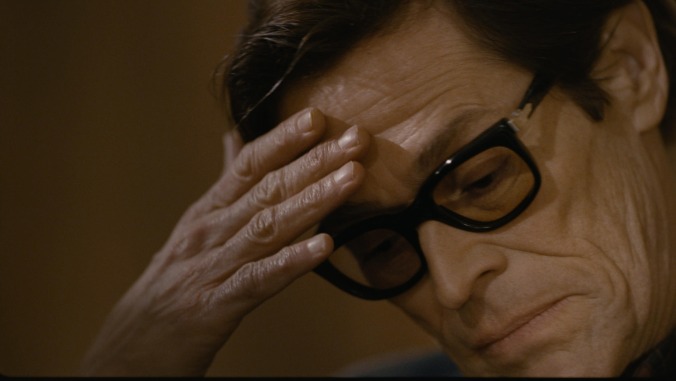The murder of the Italian director and writer Pier Paolo Pasolini on November 2, 1975—just weeks before the scheduled premiere of what would turn out to be his final and most notorious film, Salò, Or The 120 Days Of Sodom, the first part of a planned “trilogy of death”—remains a subject of morbid interest, speculation, and conspiracy theories. Did Pino Pelosi, the teenage hustler who confessed to and was convicted of the killing, really act alone? Or were there others involved? Certainly, Pasolini had enemies. An openly gay communist intellectual who didn’t always follow the party line, he had faced censorship and charges of obscenity since the publication of his first novel, Ragazzi Di Vita, in 1955, and had become a prominent figure in Italy’s culture wars. At the time of his death, he was also being extorted by an unknown party that had stolen several reels of the Salò negative from the Technicolor lab in Rome. (The same group is believed to have been behind the theft of original Venetian carnival sequence from Federico Fellini’s Casanova.) But even in the contentious and conspiratorial climate of mid-1970s Italian politics, who would go so far as to kill an artist?
A cruel and hypocritical world, says Pasolini, Abel Ferrara’s re-creation of the last 24 hours of the author and filmmaker’s life—that is, the same corrupted reality that Pasolini addressed allegorically in his work. Ferrara, who has a notorious reputation of his own, doesn’t subscribe to the theory of a lone killer (which was never supported by the forensic evidence), or to more out-there theories about Mafia hits or political assassinations. Nor does he treat Pasolini’s death as a foregone conclusion, as is often the case with biopics about celebrities whose tragic ends happen tastefully off-screen. Instead, the film largely portrays Pasolini (Willem Dafoe) as an artist perpetually at work and in conversation with his surroundings—typing, dictating, reading, meeting friends for meals, doodling with colored pencils in his free time, juggling unfinished projects, imagining his next opus as he cruises nocturnally in the Alfa Romeo that would ultimately be used to run over his body after he was beaten to death on a secluded beach in Ostia. In Pasolini, the murder becomes the story of a meaningful life coming to a meaningless end.
Ferrara knows a thing or two about the artist’s struggle against the world. A product of seamy 1970s New York, the onetime punk began his career inauspiciously, directing a porno and a cheap-o slasher movie before graduating to artsy exploitation with the 1981 rape-revenge cult classic Ms. 45. His films (including the two most famous ones, Bad Lieutenant and King Of New York) walk the line between art and its dark side—anguished chiaroscuro portraits of self-destructive characters and self-made hells, wallowing in moral decay and addiction as they grapple with a fucked-up sense of Christian guilt and redemption that rivals the best of Martin Scorsese and Paul Schrader. No one could ever accuse him of not identifying closely enough with his anti-heroes. In fact, there was a long period in his career—the years of alcoholism and heroin addiction, before he converted to Buddhism and got sober—when Ferrara seemed to be in danger of becoming one of his own characters, even though he always seemed to keep his integrity.
Surprisingly, Pasolini comes across as one of the cuddliest and least combustible protagonists in Ferrara’s body of work. Dafoe—who previously worked with Ferrara on the addiction parable 4:44 Last Day On Earth, the William Gibson adaptation New Rose Hotel, and the atypically cozy Go Go Tales, all of which are underappreciated or underseen—plays him as soft-spoken, thoughtful, and confident, his sensitive eyes almost always hidden behind vampiric sunglasses. Part of it might be Ferrara’s palpable admiration for Pasolini’s ambitions as a writer and artist. With the exception of the opening scene, which re-creates Pasolini’s final TV interview (recorded just two days before his death at a press junket in Stockholm), the film rarely mentions any of his best-known work, instead meditating on whatever might have been on his mind on the day of his death. A large chunk of the modest running time is taken up with scenes from a novel-in-progress and from Pasolini’s ambitious unproduced script Porno-Theo-Colossal, about an elderly man’s journey through cities of sin in search of a new messiah. (The latter feature Pasolini’s favorite actor and former lover, Ninetto Davoli, now old enough to play the lead role.)
In other words, Pasolini is anything but a conventional biopic, which might explain why the film, which premiered on the festival circuit in 2014, has taken almost five years to find an American distributor. But though it can be richly evocative as a mood piece (namely, whenever Ferrara gets to shroud the characters in smoky partial darkness, which is most of the time), it isn’t without its inconsistencies. The fact that Dafoe speaks most of his dialogue in English, with the rest of the cast mostly switching from English to Italian from scene to scene, produces some awkward moments, and the sequences that try to re-create the outrageous tone of Pasolini’s unfinished works don’t always gel with the dank, claustrophobic, portrait-like intensity of Ferrara’s visual style. (For such an important filmmaker, Pasolini has produced few stylistic imitators.) And yet the movie never errs in its sincerity, which extends all the way to the decision to depict Pasolini’s murder in graphic detail. For Ferrara, the art—which in Pasolini’s case included fiction features, documentaries, novels, plays, volumes of poetry, and essays—is the forensic evidence of an artist’s visionary inner life. There might be more than a little self-identification there, given the director’s own production and distribution woes: Oh, if only you could see all the movies we don’t get to make.


